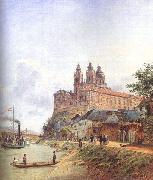|
|
|
|
|
Jakob Alt
|
|
The_Monastery_of_Melk_on_the_Danube
|
|
The_Monastery_of_Melk_on_the_Danube,_oil_on_canvas
_
Date_1845(1845)
_
cjr
|
|
|
|
|
|

|
|
Click to Enlarge
|
| Jakob_Alt
|
The Monastery of Melk on the Danube
new24/Jakob Alt-946866.jpg
|
|
|
|
|
|
| The Monastery of Melk on the Danube, oil on canvas
Date 1845(1845)
cjr |
|
|
1789-1872
Austrian
Jakob Wassermann was born on March 10, 1873, in Furth, the son of a Jewish merchant. After a childhood with many restrictions, he began his career as an office clerk, in Munich and then in Freiburg. In 1898 he moved to Vienna and eventually established himself as a writer. Derivative and imitative, Wassermanns novels showed from the outset a strong dependence upon Fyodor Dostoevsky - particularly in his fondness for the psychological probing of criminals and social outcasts - as well as the influence of the master of the romantic horror and detective story, E. T. A. Hoffmann.
Wassermanns first significant work is Die Juden von Zirndorf (1897, The Jews of Zirndorf), in which his deep knowledge of his own community in F??rth and Nuremberg stands him in good stead. As in many of his other works, Wassermanns preoccupation with innocence and redemption is here interleaved with a somewhat crass depiction of depravity and superstition. Der Moloch (1902) pays tribute to the contemporary literary cult of the great city (here Vienna), seen as an all-devouring monster of sin and perversion. Caspar Hauser (1908) is probably the authors best novel; the book, based on fact, deals with the case of the mute youth who appeared one day in 1828 on the streets of Nuremberg. Resemblances to Dostoevskys The Idiot may also be noted in this tale of the rejection and contamination of innate purity by corrupt society.
After Caspar Hauser Wassermanns novels and short stories become increasingly preoccupied with bizarre and perverse anecdotes and intrigue, often initially drawn from biography or the newspapers. Das Gansemannchen (1915; The Goose Man) illuminates the problem involved in simultaneous cohabitation with two wives. Christian Wahnschaffe (1919) exploits the theme of the rich mans son who rejects the world to turn toward Buddhism. Der Fall Maurizius (1928, The Mauritius Case) is a type of detective novel made colorful by excursions into hypnosis but also weighed down by a tedious mass of psychological dissection. Like Honor?? de Balzac, whom he imitated, Wassermann introduces the same characters into different novels; thus Etzel Andergast (1931) is a sequel to The Mauritius Case, and its hero, Joseph Kerkhoven, reappears in Joseph Kerkhovens dritte Existenz (1934, Joseph Kerkhovens Third Existence).
Wassermann is a somewhat uneven and labored writer, and he cannot in any sense be considered a stylist. His novels are often marred by diffuseness and miasmic obscurity. At the same time his extensive output is of considerable historical interest and illuminates rather well the consequences of marriage between the new depth psychology and the popular novel of sensation and crime. He died on Jan. 1, 1934, in Alt-Aussee.
|
|
|
|
|
|
|